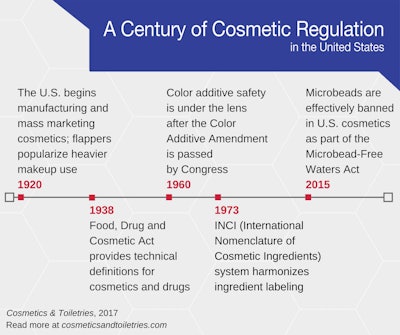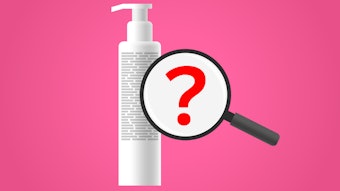
Much has changed in the cosmetic and personal care industry in the past century. Cosmetics & Toiletries spoke with David Steinberg, President, Steinberg & Associates, on some of the landmark regulatory events in the industry. Starting with the inception of the modern U.S. Food & Drug Administration (FDA), read on for an overview of regulation history.
Log in to view the full article
Much has changed in the cosmetic and personal care industry in the past century. Cosmetics & Toiletries spoke with David Steinberg, President, Steinberg & Associates, on some of the landmark regulatory events in the industry. Starting with the inception of the modern U.S. Food & Drug Administration (FDA), read on for an overview of regulation history.
1906
Pure Food and Drugs Act is passed as a reaction to The Jungle by Upton Sinclair, laying the groundwork for the modern FDA as a consumer protection agency.
1920
Food and Drugs Act is passed in Canada.1
1927
FDA takes over responsibility for enforcing the Pure Food and Drugs Act. The FDA was originally called the Food, Drug and Insecticide Administration before being renamed in 1930.2
1938
Food, Drug and Cosmetic Act is passed, defining the technical differences between cosmetics and drugs—under this definition, a cosmetic must be intended for cleansing, promoting attractiveness, etc., for human use.
1944
The Draize eye and skin irritancy test is invented by FDA toxicologist John Henry Draize, Ph.D., which tests on animals for cosmetic safety.3
1958
The most common red color is flagged as a possible carcinogen and forbidden after the passing of the Delaney Clause as part of the Food Additives Amendment, which forbids food-containing chemical additives that may cause cancer in animals or humans to be sold.
GRAS (Generally Recognized As Safe) first published in the Federal Register, listing almost 200 substances shown to be safe for their intended use.4
1960
Color Additive Amendment is passed by Congress, defining a "color additive" and limiting additives in cosmetics, foods and drugs to those deemed "suitable and safe."2
"Natural" products entered the cosmetic scene, based on botanical ingredients.4
1967
Fair Packaging and Labeling Act enacted by Congress with the goal to prevent consumer deception of ingredients, characterizations, etc., with honest labeling on consumer products.2
1970
The Cosmetic, Toiletry and Fragrance Association (CTFA) is formed when the Toilet Goods Association (TGA) changes its name.4
1972
Over-the-Counter (OTC) Drug Monograph Process establishes standards (monographs) for OTC drugs, evaluating the safety and effectiveness of these drugs in the United States using a three-phrase rulemaking process.
1976
The CTFA and FDA establish the Cosmetic Ingredient Review (CIR) Expert Panel to review the safety of cosmetic ingredients.4
1978
FDA begins work on a first draft of proposed rules for sunscreen regulations; these rules have been drafted over the past few decades but not published due to issues concerning UV protection.
1973
INCI (International Nomenclature of Cosmetic Ingredients) system established by the CTFA.
1998
The United Kingdom bans animal testing for cosmetics.3
2004
Natural Health Products (NHP) Regulations go into effect in Canada and define NHPs as vitamins and minerals, herbal remedies, homeopathic and traditional medicines, probiotics and other essential acids.1
Canada's Cosmetic Ingredient Hotlist is launched, a regularly updated list of substances and ingredients that are limited or banned in cosmetics.1
2007
European Chemicals Agency (ECHA) is founded to implement E.U. chemical legislation.5
REACH (Registration, Evaluation, Authorization and restriction of Chemicals) guidelines are introduced, placing responsibility on companies in the E.U. to identify and manage risks in chemical substances.5
The CTFA changes its name to the Personal Care Products Council.4
2009
CLP (Classification, Labeling and Packaging) Regulations are introduced in the E.U. to ensure transparency on chemical hazards to consumers and workers through labeling and classification.5
2015
Microbead-Free Waters Act is passed, prohibiting manufacturing, packaging and distribution of microbead-containing rinse-off cosmetics.
 *Unless otherwise noted, timeline events take place in the United States.
*Unless otherwise noted, timeline events take place in the United States.









